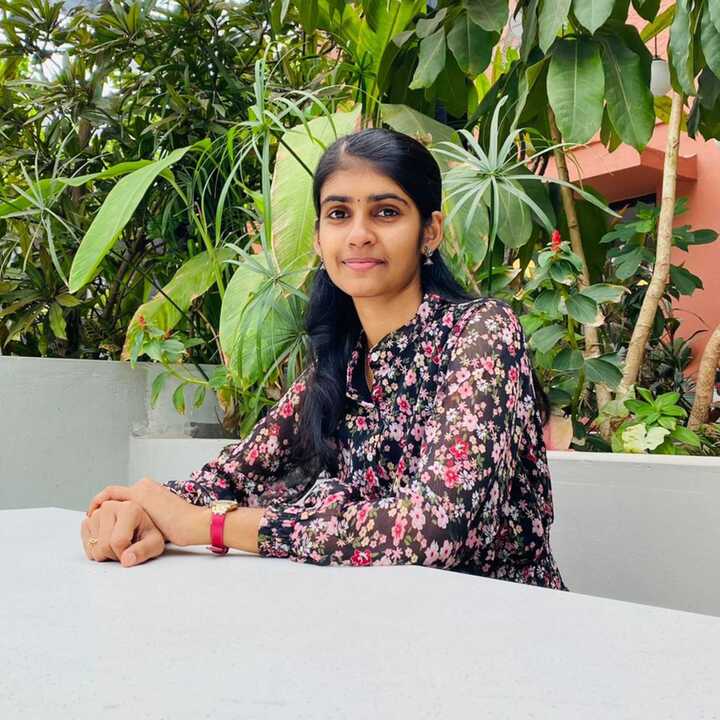“Setting goals is the first step in turning the invisible into the visible.”
- Anthony Robbins
Have you ever found yourself in a situation where you work without setting a goal? Imagine a ship adrift in the middle of an ocean, without a thought about its destination. Without a destination the ship is left behind, not knowing which direction to move. Here comes the rescuer: GOALS. Goals act as the guiding wind to move towards the destination to reach success.

Having understood the goals, let us understand the Employee goal-setting process. But wait - before delving into the topic, there are certain questions you need to ask yourself:
- Do you have a clear deadline before setting them?
- How does your goal align with the organization?
- How will you know when the goal is achieved?
Generally, businesses would have sufficient time, money or assets, yet they often lack something crucial. Guess what? It is setting clear goals for employees in the workplace. Without understanding the company goals, it is challenging to achieve desired results.
What is Employee Goal-Setting?

Goal setting helps employees understand their roles, enhances engagement and retention, and contributes to broader organizational objectives. It leads to improved productivity, efficiency and innovation. These goals are set for individual employees to attain the target within the timeframe. Setting a clear goal helps individuals and teams understand how their work contributes to the overall success of the organization. Goals should be measurable, and this is where the manager’s role comes in. Managers can track employees' efforts and guide them to reach their goals.
For instance, Jackson, a social media expert, aims to increase LinkedIn followers by 15% over the next six months. By employing this measurable goal, Jackson can track his progress and work towards achieving it. This contributes success of his entire team, leading to the overall business success.

Types of Employee Goal-Setting
Effective business goals are specific and measurable. Clear goals help keep employees motivated and accountable. Further, business goals can encourage and reach the destination without effort. Here are the types of Employee Goal-Setting:
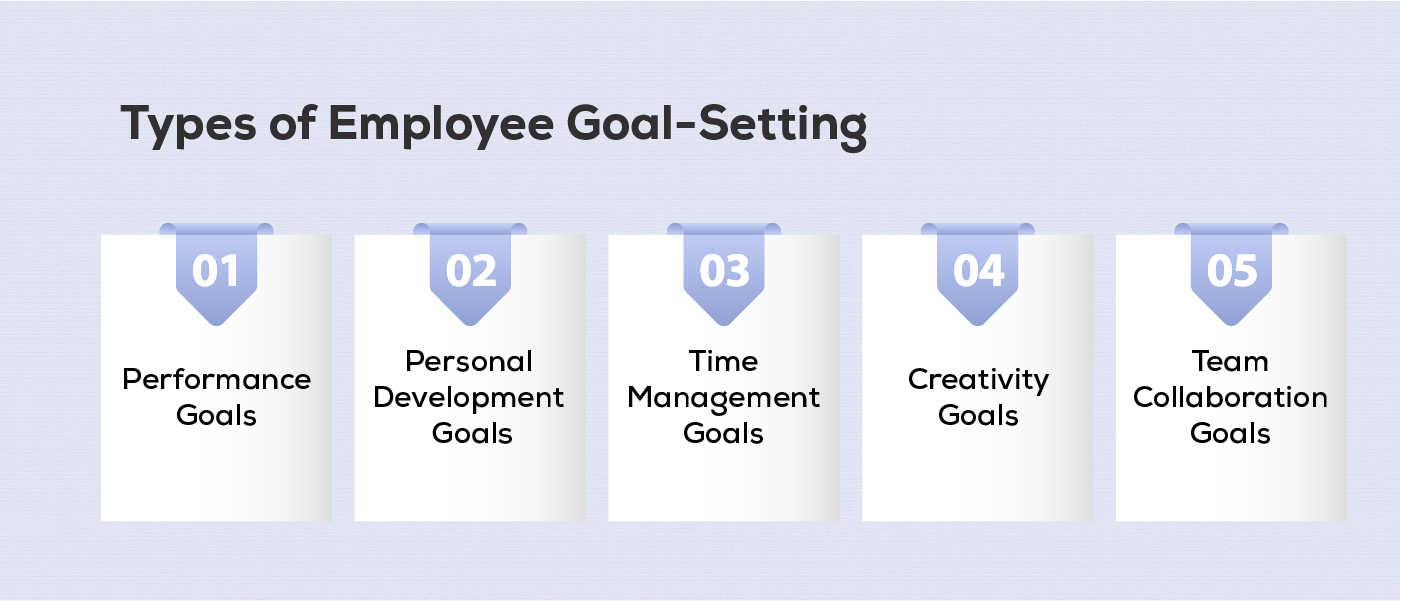
1. Performance Goals
Employee performance goals stand as the cornerstone of a business plan. They stand as the short-term objective that needs to be focused to meet the organizational goals. Expectations from employees are defined through these performance goals, which offer several advantages, including opening opportunities, fostering productivity and enhancing accountability.
Example - Brand visibility can be enhanced through multi-channel marketing to reach a broader audience. Consider PR campaigns with the goal of reaching 10,000 impressions per month.
2. Personal Development Goals
Is there anyone who prefers to hang stagnant in their career without advancement? No, right! This indirect goal focuses on learning and professional growth contributing to the organization's goals. It focuses on helping employees attain skill enhancement, capabilities and knowledge that offer a way to success.
Did you know? The global personal development market size in 2022 was valued at USD 43.77 billion and is anticipated to grow at a CAGR of 5.5% from 2023 to 2030.
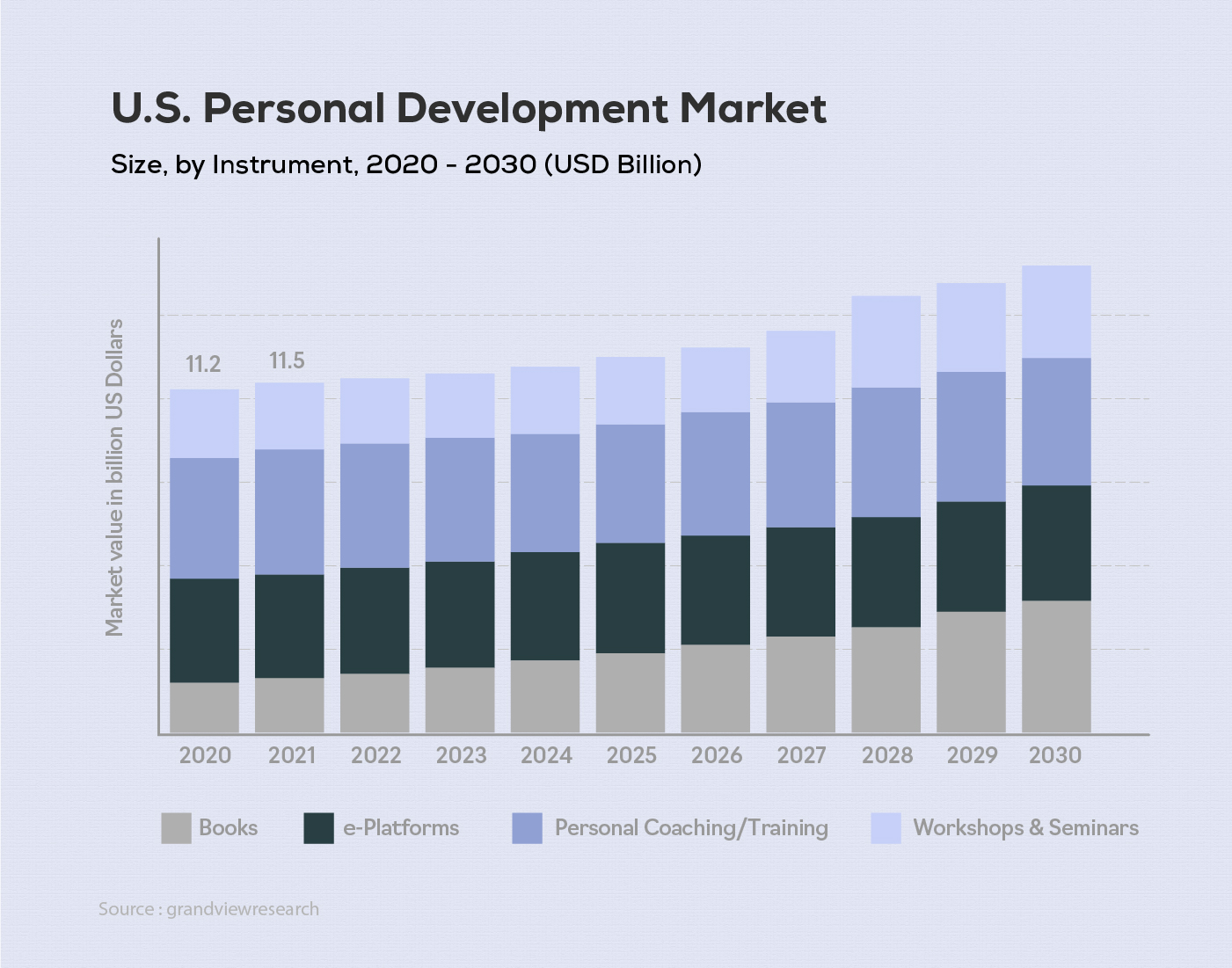
For example - Learning a programming language helps to boost your career and strengthen your profile for the future. Examples include learning Java, Ruby or Python.
3. Time Management Goals
Effective time management skills involve prioritizing tasks, setting deadlines and avoiding distraction. This can lead to increased productivity, reduced costs, and improved overall performance. One of the common methods to prioritise time management goals is through the SMART goal:
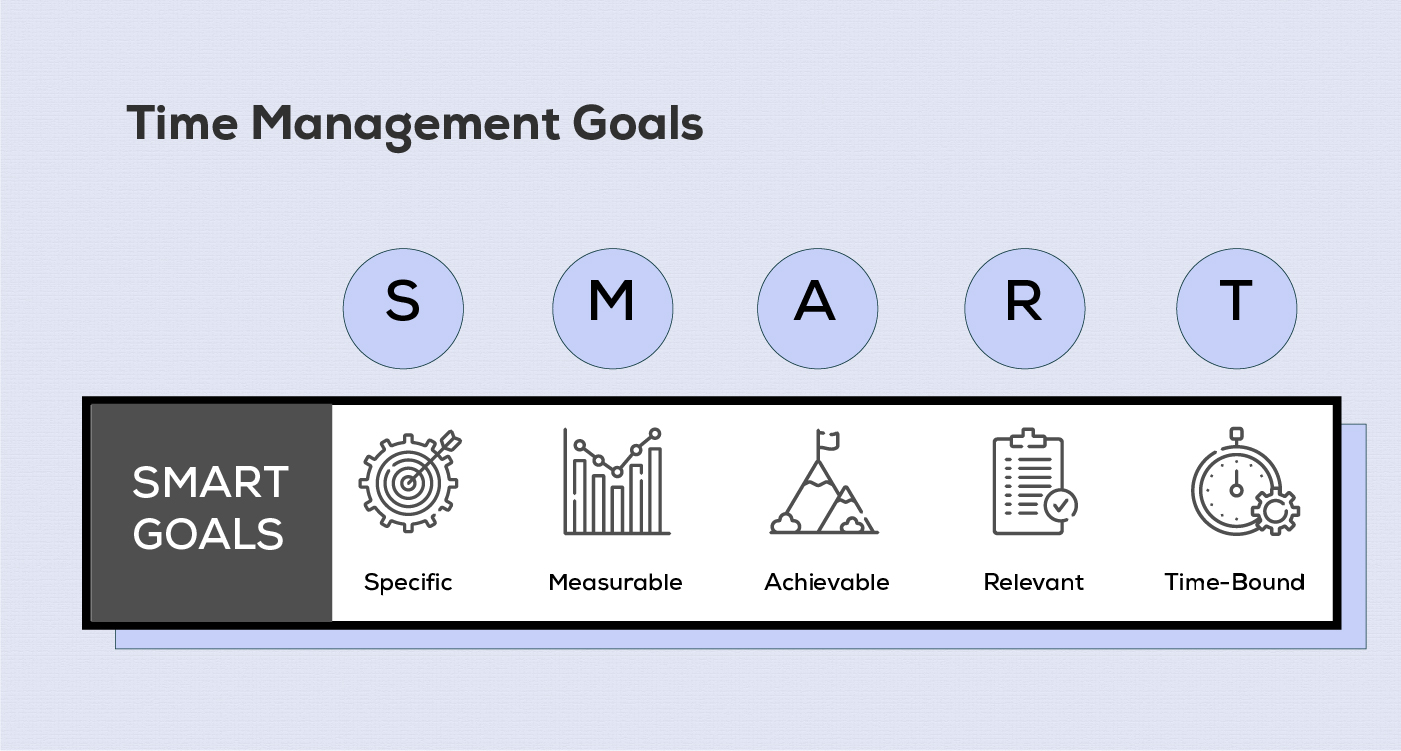
- Specific - The goals are specific and clear.
- Measurable - Specific criteria for measuring the goal.
- Achievable - Goals to be set that are achievable.
- Relevant - To ensure the goals align with the organization and are relevant.
- Time-Based - Assign a deadline for the goal and complete it within the time frame.
Watch the video below to get insight into setting a SMART Goal:
Example - The goal of increasing the blog traffic by 10% can be attained by setting a goal by the end of the month, thereby generating more leads. This can easily be achieved through SMART goals.
4. Creativity Goals
Creativity and innovation are the keystones to drive success and remain ahead in the market landscape. By encouraging employees to think creatively, companies can promote a culture of innovation that creates room for new opportunities and drives success. The creativity goals allow employees to work by pushing the boundaries.
Here comes an interesting survey on staying creative at work.
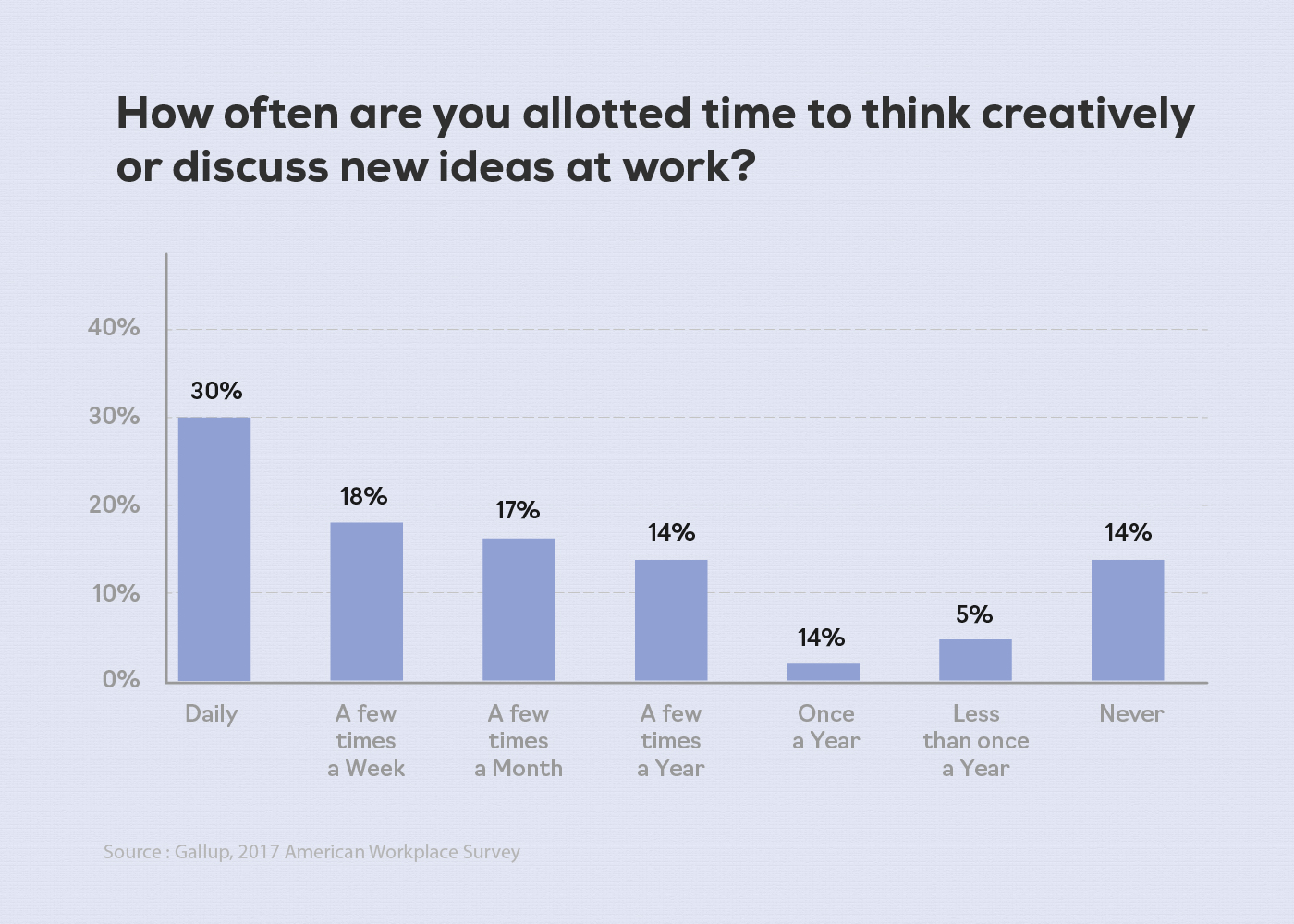
For instance - An employer can set a goal to improve and create 10 new products that meet the customer needs. He can ensure that the product remains competitive and useful for the customers.
5. Team Collaboration Goals
“Alone we can do so little; together we can do so much”
- Helen Keller
As this quote describes the importance of teamwork and collaboration, so is the definition of team collaboration goal. It involves the team members in the process of defining goals and establishing clear objectives. It includes recognizing the company's needs, assigning resources, and estimating the timeline. Also, it is noted that communication skills play an important role in setting collaboration goals.
A recent study reveals that nearly 3 in 4 employers rate teamwork and collaboration as “very important”.
For example - Creating a space for employees, where they can actively raise their opinions, ideas and feedback, leading to collaboration and success.
Benefits of Goal-Setting
Goal-setting helps employees reach their destination and attain the goal without stress. It helps to utilize the time effectively, increase focus, be productive and improve the quality of decision-making. The benefits of goal-setting include:
- Greater productivity
- Increased motivation
- Clear direction and focus
- Measurable success
- Enhanced ngagement at work
- Improved organisational performance
- Higher customer Satisfaction
- Regular Feedback
Top 10 Examples of Employee Goal-Setting
1. Personal Goals
Goal – Learn a new skill
Focus on learning a public speaking skill that boosts your confidence. It also stands as a personal development skill that helps during client meetings or team meetings.
2. Team Collaboration
Goal – Getting Feedback
Positive feedback plays an important role in team collaboration. It is directly linked to productivity and employee engagement. By reducing negative behaviors, it helps individuals recognize their strengths and weaknesses.
3. Time Management Goals
Goal – Set a realistic deadline
By setting realistic deadlines, employees can improve your time management, reduce stress and increase the likelihood of successful competition.
4. Leadership Goals
Goal – Offer constructive feedback
Providing employees with constructive feedback helps them identify areas for development. It guides them with positive and constructive criticism to support their growth.
5. Soft Skills
Goal – Problem-Solving
While there are many soft skills, problem-solving skills are crucial for identifying issues and finding effective solutions. By making informed decisions, employees can better understand problems and determine the best possible solutions.
6. Communication Skills
Goal – Be clear and concise
Many people lack communication skills so they tend to add filler words, pause and add unnecessary details. The audience might lose interest if their message is not set clear and concise.
7. Listen Actively
Goal – Be fully present
Active listening means being present in the conversation that is going ahead. It is to give proper attention to the speaker. Avoiding distraction, daydreaming, and putting down the internal dialogue all contribute to active listening.
8. Build a Network
Goal – Build with “hi”
Building a relationship simply starts with the word “hi”. This starts the setting stage to connect with people and build connections. A thoughtful outreach supports being respectful and having productive leadership roles.
9. Organizational Goal
Goal – Defined workflow
A well-defined workflow ensures that everything is in demand and not a single stage gets skipped. It is to make sure that the ongoing process is on track.
10. Performance Motivation
Goal – Allow mistakes
Permitting employees to make mistakes and learning from them motivates the team members to take risks, thereby leading to a learning environment.
Goal-Setting Software
In the market landscape, you get to try different types of tools for your organization. Here is the list of top Goal-Setting software that can change your plan.
Why wait? Dive deep to gain insights.
1. ClickUp
It is designed to be user-friendly both for individual users and large teams, irrespective of the industry trends. ClickUp can manage workloads, collaborate with teams and manage projects. This software helps to track the goals along with the timelines and measure targets.
Features:
- Motivates the team
- Creates a shared focus on a common goal
2. Weekdone
Weekdone works to let the employees track the team and provide proper feedback. For employees, this tool provides clear team goals, an understanding of individual goals and contributions and provides feedback on performance.
Features:
- Track goal-setting
- Report weekly status updates
3. Asana
The features of Asana allow users to create strategic plans, set measurable goals, and communicate updates. You get the option of sorting projects like – due date, status, project owner, custom field etc.
Features:
- Using templates to standardize goal-setting
- Creating custom views to see the most relevant information
4. Trello
Trello utilizes a popular organizational technology, Kanban boards to track project workflow and progress. To view the task list, you get to view the lists and cards.
Features:
- Easy to set goals
- Break down the bigger tasks into smaller ones
5. Lattice
Lattice allows you to track the goal along with daily routines like status updates, performance checks, one-on-ones etc.
Features:
- Integrates employee engagement with continuous performance.
- It enables tracking Objectives and Key Results (OKRs)
Conclusion
“A goal properly set is halfway reached.”
To gain long-term success, goal-setting is essential. Well-defined goals benefit both individuals and organizational performance. Effective goal-setting involves all levels of the organization, ensuring everyone understands their role in achieving the broader vision. The goal that is set should be highly effective and should encourage the employees for better performance.



